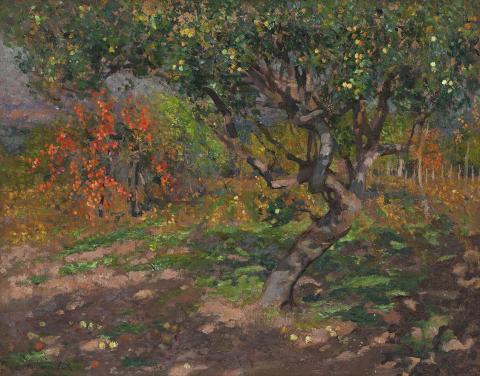APPLE TREES, c.1908
EMANUEL PHILLIPS FOX
oil on canvas
51.0 x 64.0 cm
signed lower left: E Phillips Fox
Private collection
Christies, Melbourne, 1970, lot 103
Joseph Brown Gallery, Melbourne
Charles Nodrum Gallery, Melbourne
Private collection, Melbourne
Private collection, Hobart
Catalogue of Pictures by the late E. Phillips Fox, The Fine Art Society, Melbourne, 7 – 11 May 1925, cat. 5
Emanuel Phillips Fox, Clune Galleries, Sydney, 12 October – 12 November 1971, cat. 16
Joseph Brown Gallery, Melbourne, 1973
19th and 20th Century Australian Painting, Sculpture and Decorative Arts, Lauraine Diggins Fine Art, Melbourne, 14 May – 7 June 1996, cat. 16
Collectors’ Exhibition 2017, Lauraine Diggins Fine Art, Melbourne, 3 June – 29 July 2017 (illus. in exhibition catalogue, pp. 8 – 9)
Zubans, R., E. Phillips Fox His Life and Art, The Miegunyah Press, Melbourne, 1995, cat. 287, p. 224
Apple (Pear?) Blossoms, c.1907, oil on canvas, 45.7 x 38.8 cm, illus. in Zubans, R., E. Phillips Fox His Life and Art, The Miegunyah Press, Melbourne, 1995, cat. 253, p. 84
The Victorian goldrushes drew many talented people to Australia, among them the London photographer Alexander Fox and barrister Brice Bunny, what S. T. Gill might dub the ‘gentlemen diggers’. Their most eminent sons, Emanuel Phillips Fox and Rupert C. W. Bunny were fellow students at Melbourne’s National Gallery schools. Later studying in Paris, they both achieved international recognition during the very heydays of la belle époque. In 1894 Fox won a gold medal at the Salon of the Société des Artistes Français, with his Portrait of My Cousin, 1893 – 94, now in the collection of the National Gallery of Victoria through the Felton Bequest. He was the first Australian to win such an award. Fox and Bunny exhibited extensively in the Paris Salons and the London Royal Academy. A year different in age, their friendship drew closer after Fox married the urbane English artist Ethel Carrick, their London wedding, in the spring of 1905, attended by a large number of visiting and resident Australian artists. Settling in Paris near the Luxembourg Gardens, not far from where Bunny and his beautiful French wife Jeanne lived, it remained their home until 1913. The Fox scholar, Ruth Zubans, noted:
This period was to become one of the most fertile in Fox’s career, and saw the emergence of a clear focus of interest – that of subject painting. Now a fresh range of themes came to the forefront: scenes of domesticity, the home and garden, the city with sunlit parks and boulevards, beach scenes of fashionable summer resorts and paintings of the nude. 1
Many of Fox’s finest paintings come from this time – Al Fresco, c.1905, in the collection of the Art Gallery of South Australia, Adelaide; Motherhood, 1908, Art Gallery of New South Wales, Sydney; Bathing Hour, c.1909, Queensland Art Gallery, Brisbane; and The Ferry, c.1910-11, Art Gallery of New South Wales. Fox and his wife painted enticing moments of Paris, Normandy, and Venice in the spring of 1907. Of Sydney Harbour in 1908, and from 1909 to 1911 they captured the sunlit beach resorts at Trouville, Dinard and Royan, the latter a favourite place for Bunny. Numerous smaller works, as studies for larger subject pictures or exquisite paintings in their own right, formed an important part of their oeuvre.
In 1908, the Foxes made a seven-month visit to Australia where they stayed with Fox’s mother Rosetta in the Melbourne suburb of Malvern, and often painted in his brother’s garden in East Malvern. They continued their interest in a similar range of subject pictures and landscapes. The Lattice Gate, 1908 (private collection), for example, was a study for the background of Motherhood, 1908 (Art Gallery of New South Wales), and Portrait of Len, 1908 provided an engaging study for The Arbour, 1910 (National Gallery of Victoria, Felton Bequest). The Lattice Gate and The Garden Walk, 1908 (private collection), are intimiste in mood, harking back to the more green dominated palette of Fox’s Charterisville landscapes of 1900.2 Nevertheless, the impact of Impressionism and the French style had long held sway in his art, as in the lively painting of Apple Blossoms, c.1907 (private collection, Sydney) and other orchard scenes. Our painting, Apple Trees, c.1908, is thoroughly French in feeling, its joie de vivre expressed through its rich colours, lively patterns of light, and textured surface. The overall emphasis on colour and texture gives the painting the feel and fascination of a Persian carpet, carried through into the imagery emerging from abstraction, illusions of depth within the flatness of the picture plane. Moreover, it has the added vibrancy of a plein air painting. When Fox exhibited a large number of his paintings at the Grosvenor Rooms, Sydney, in 1908, the writer for the Sydney Morning Herald described him as ‘an artist of wide range’. Continuing, he wrote: There are distinction and refinement in all his best works, whether in portraiture, figure painting, landscape, or seascape. He can be somber or gay, careful or carefully impressionist, decidedly French in some of his moods, and sometimes quite classic in his modernity …’.3 For Apple Trees, Fox extended his ‘carefully impressionist’ manner to embrace some of the strong colours of the Fauves, enlivening his academic background with like influences of other moderns, all dappled sunlight. When exhibited and then auctioned at the Fine Art Society’s Gallery, Melbourne, in May 1925, Apple Trees was in the august company of such masterly paintings as The Art Students, 1895 (Art Gallery of New South Wales); The Love Story, 1903 (Art Gallery of Ballarat, Victoria); and The Bathing Hour, c.1909 (Castlemaine Art Museum, Victoria).
1. Zubans, R., E. Phillips Fox: His Life and Art, The Miegunyah Press, Melbourne University Press, Melbourne, 1995, p. 121
2. ibid., p. 125
3. ‘The Phillips Fox Exhibition’, Sydney Morning Herald, Sydney, 22 June 1908, p. 5
DAVID THOMAS
